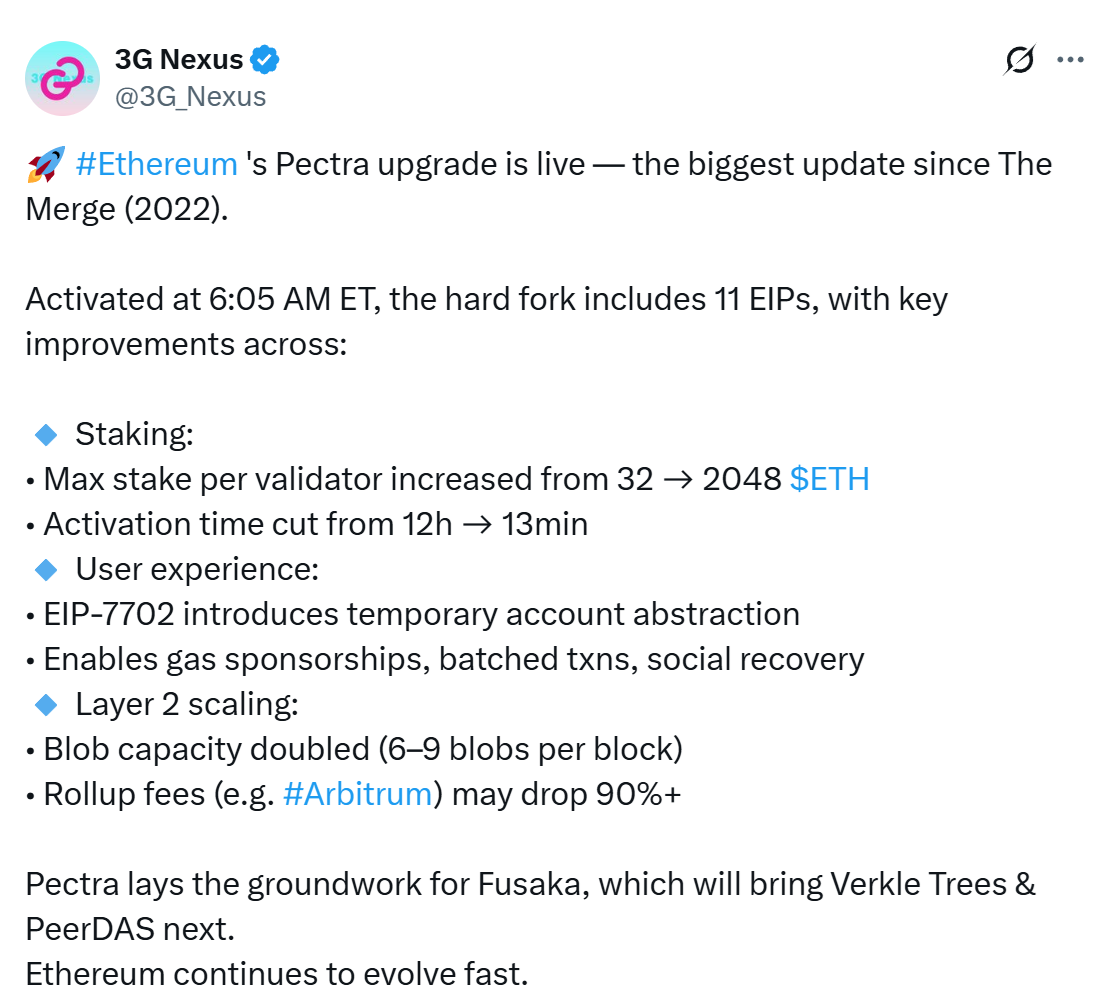2025-05-08

Ethereum has activated its most important network overhaul since the 2022 Merge, launching the
long-anticipated “Pectra” upgrade on May 7 at 10:05 UTC.
The hard fork, named after a blend of
“Prague” and “Electra,” introduces sweeping changes aimed at improving staking
flexibility, wallet usability, and blockchain efficiency.
After nearly 18 months in development
and two failed testnet trials, the upgrade went live on Ethereum’s mainnet and
finalized within 13 minutes.

3G Nexus on X: "🚀 #Ethereum 's Pectra upgrade is live — the biggest update since The Merge (2022).
Key Features: Smart Wallets and Bigger
Stakes
Two main Ethereum Improvement Proposals
(EIPs) define the Pectra upgrade:
EIP-7702 brings account
abstraction a step closer to reality. It enables regular Ethereum wallets to
temporarily act like smart contracts.
That means users could soon batch
multiple actions, pay gas fees in stablecoins, or recover lost wallets, features
long viewed as critical to mainstream adoption.
EIP-7251 raises the
maximum stake per validator from 32 ETH to 2,048 ETH, a move designed to ease
infrastructure demands on large staking providers. This allows validators to
consolidate rather than spin up hundreds of separate nodes, reducing
operational costs and freeing up space in the queue for new participants.
“This means small operators can
compound their stake directly, while large ones can consolidate validators to
reduce bandwidth use,” said Tim Beiko, Ethereum Foundation protocol lead.
Until now, staking large sums of ETH
required complex validator setups, often split across dozens—or hundreds—of
nodes. The new 2,048 ETH limit is expected to simplify participation,
particularly for institutions, and potentially strengthen the network’s
decentralization and security.
Interest in Ethereum staking has surged
since 2024. Analysts see Pectra as a catalyst for more institutional inflows,
especially as Ethereum competes with faster-moving rivals like Solana.
Beyond staking and smart accounts, the
Pectra upgrade includes nine additional EIPs targeting validator efficiency,
cryptographic operations, and scalability:
EIP-7691 doubles
Ethereum’s blob throughput, enhancing Layer 2 performance and reducing fees for
users on rollups.
EIP-7002 improves
validator withdrawal security.
EIP-2537 and EIP-2935
boost cryptographic speed and data accessibility, aiding privacy and
verification tools.
Despite the technical leap, markets
barely reacted, likely because the upgrade had been priced in. Ethereum’s last
major rally occurred in late April.
Still, Pectra lands at a delicate time.
Ethereum has steadily lost market share to faster and more developer-friendly
chains.
The Ethereum Foundation recently
introduced new leadership and plans to re-energize its ecosystem.
This upgrade could be the start of a
reset. By fixing long-standing friction points and easing institutional access,
Ethereum aims to solidify its lead as the premier smart contract platform.
While not as dramatic as the switch to
proof-of-stake, Pectra might prove more consequential in the long run. It
tackles real-world usability, scalability, and infrastructure bottlenecks.